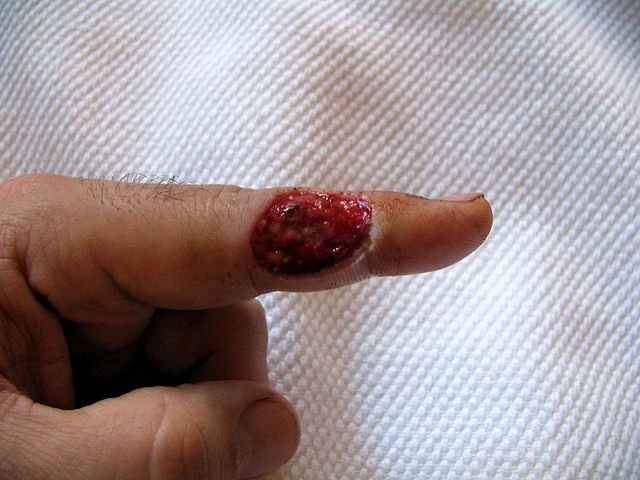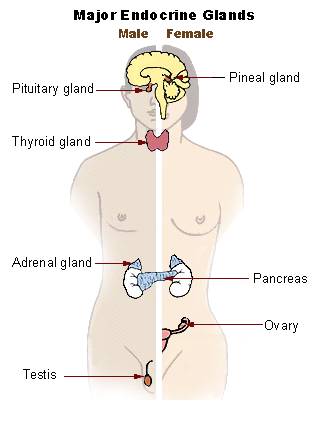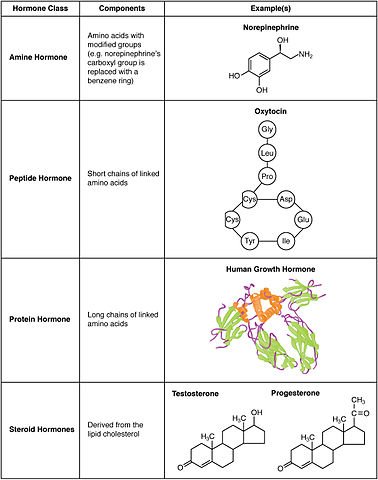We usually think of hormones as complex chemicals that occur in the human body. But hormones control all sorts of processes in all sorts of organisms. The vital part that one hormone plays in the life cycle of an insect, the European fire bug, was discovered by accident. In the 1950s, a young Czech scientist, Karel Sláma, travelled from Europe to Harvard University, carrying a small number of European fire bugs. This insect develops in five nymph stages, shedding its skin each time it grows. After the last moulting, it becomes an adult, capable of reproduction. When he arrived, Sláma was astonished to find that his bugs had not changed into mature adults: they had moulted more than five times and had grown into abnormally large nymphs.
The paper lining the insects’ cages seemed to be responsible. Cages lined with The Times or the science journal Nature produced normal insects but those lined with The New York Times or Scientific American produced large nymphs. Sláma and his colleagues later showed that wood pulp from balsam fir, used to make the paper for some North American publications, contains a chemical that mimics insect juvenile hormone. This hormone prevents development from nymph to adult, But why should a tree mimic an insect hormone? Could it be a defence mechanism against aphids? Aphids that attack the balsam fir absorb the hormone and are then unable to mature into reproductive forms. Their colonisation attempt fails, and the tree remains free from aphids. Sounds interesting! Eh?
HORMONES ARE CHEMICAL SIGNALS
Chemical signals are produced by most living organisms. In plants, they control processes such as growth and flowering. Animals use a wide variety of chemical signals to control and co-ordinate many aspects of their everyday life. In mammals, there are three main types of chemical signal:
- Locally acting chemicals such as prostaglandins, endorphins and histamines. These act on cells that are close to their site of production.
- Hormones. These are produced by special tissues called endocrine glands. They pass into the blood and act away from their site of production. Hormones affect target cells and target organs in the body.
- Pheromones are chemical messengers that allow external communication: simple exchanges of information between people. Generally, pheromones are not an important means of communication in humans, despite the claims of some newspaper reports and advertisements.

An open wound. Sadeq Rahimi, Self-photographed, Attribution
Histamine is a local messenger which is released by injured cells. It acts on the cells around an injury like the deep cut shown above, causing blood vessels near to the injury to dilate, bringing more blood into the area. This is an important part of the inflammation response.
In this post, I will look at how chemical signals control many life processes in animals, concentrating on the systems that occur in humans. I will focus mainly on hormones. The definition of a hormone in mammals is:
A chemical messenger that is produced by cells or tissues of the endocrine system and that travels through the blood to act on target cells or target organs, before being broken down.
The main part of the post describes the human endocrine system and I finish with a brief overview of prostaglandins and endorphins and the effect of pheromones on animal behaviour.
THE HUMAN ENDOCRINE SYSTEM
In humans, more than a dozen tissues and organs produce hormones. Some, including the pituitary gland, the thyroid gland, the parathyroid glands and the adrenal glands, are endocrine specialists: their mains function is to secrete one or more hormones. Others, such as the pancreas, ovaries and testes, secrete hormones in addition to their other functions. Together, these glands make up the endocrine system. There are two basic types of gland in the body: exocrine glands (e.g. salivary gland), whose secretions are released through a tube or duct; and endocrine glands (e.g. thyroid gland), which have no ducts, so they shed their secretions directly into the bloodstream for transport to their eventual destination. The endocrine system has four main functions:
- It maintains homeostasis, the balance of the body, by making sure the concentration of many different substances in body fluids are kept at the correct level. The control of blood sugar level, blood pH and water balance are examples of homeostasis.
- It works with the nervous system to help the body respond to stress. The release of adrenaline in the fight or flight response is an example of this.
- It controls the body’s rate of growth.
- It controls sexual development and reproduction.
We know of more than 50 human hormones, and we divide them into two groups according to their origin: those made from fatty acids and those made from amino acids. The first group, which includes steroids such as oestrogen and progesterone, are lipid-soluble. Hormones based on amino acids are modified amino acids, peptides or glycoproteins: they are water-soluble and include insulin and adrenaline. The table below lists most of the hormones produced by the endocrine system and shows where they act and what they do. You might find it useful.

Location of major endocrine glands. US Government , Public Domain
HUMAN ENDOCRINE GLANDS AND THEIR PRINCIPAL SECRETIONS.
Gland | Hormone | Chemical structure | Effect | |
Pituitary 1. posterior lobe | anti-diuretic hormone (ADH) | Peptide | Reduces amount of water lost in urine, Raises blood pressure by constricting arterioles | |
| oxytocin | peptide | contraction of smooth muscle during childbirth. Stimulates secretion of milk from mammary glands | ||
| 2. anterior lobe | adrenocorticotrophic hormone (ACTH) | Peptide | Stimulates production and release of hormones from adrenal cortex | |
| follicle stimulating hormone (FSH), also called ICSH in males. | Glycoprotein | Controls the development of follicles in the ovary, and sperm cells in the testes | ||
| growth hormone | protein |
| ||
| luteinising hormone (LH) | glycoprotein | Stimulates ovulation and formation of the corpus luteum (stimulates testosterone production in males) | ||
| Prolactin | protein | Stimulates milk production and release | ||
| thyroid stimulating hormone (TSH) | glycoprotein | Stimulates growth of thyroid gland; synthesis and production of thyroid hormones | ||
| Thyroid | Thyroxine + Triiodothyronine | iodine-containing amino acids | Thyroxine increases rate of cell metabolism, controls aspects of growth and development, and controls basal metabolic rate (BMR) | |
| Parathyroid | parathormone | peptide | Raises blood calcium levels by stimulating release of calcium from bone | |
| Pancreas (islets of Langerhans) | insulin (produced by the β cells) | protein | Lowers blood glucose levels by making cell membranes more permeable to glucose, increases glycogen storage in liver | |
| glucagon (produced by the α cells) | peptide | Raises blood sugar levels by stimulating glycogen breakdown in the liver | ||
Adrenal 1. cortex | glucocorticoids, e.g. cortisol | steroids | In response to stress, raise blood glucose | |
| 2. medulla | adrenaline | modified amino acid | ‘Fear, flight and fight’ reactions. Prepares the body for heightened activity. Mimics effects of the autonomic nervous system | |
| noradrenaline | modified amino acid | As adrenaline | ||
| Gonads 1 ovary (follicle) | oestrogens | steroids | Female sex characteristics, rebuilding of uterus lining after menstruation, inhibit FSH | |
| 2 ovary (corpus) | progesterone | steroids | Stimulates maturation of uterus lining, maintains pregnancy, inhibits FSH | |
| 3. testis | androgens, e.g. testosterone | steroids | Support sperm production. Important in the development of male secondary sexual characteristics | |
| Placenta | human chorionic gonadotrophin (hCG) | steroids | Causes corpus luteum to secrete progesterone, thus maintaining pregnancy |
Endocrine glands are tissues and organs that produce and release hormones. These glands have no ducts. The hormone is simply secreted into the blood and then travels to target organs or cells elsewhere in the body. A good example of an endocrine gland is the adrenal gland.
Hormones are formed inside endocrine cells. Some amino acid-based hormones, such as insulin and glucagon, are produced directly from a copy of a gene by the processes of transcription and translation. Most hormones, including the steroids, are made as an end product of a series of chemical reactions. Each reaction makes minor changes to precursor molecules, until, eventually, the active hormone is produced. For the steroid hormones progesterone, oestrogen and testosterone, the precursor is cholesterol.
Thyroxine: an example of negative feedback
Metabolic rate is the rate at which all cells in the body carry out their biochemical reactions. It is a vital whole-body function that must be controlled within very strict limits. The hypothalamus in the brain detects even a small decrease in metabolic rate and responds by releasing more thyrotropin releasing hormone. This acts on the pituitary gland, causing it to release more thyroid stimulating hormone. This passes to the thyroid gland, which responds by secreting more thyroxine, the hormone that acts on individual cells to increase metabolic rate. As soon as metabolic rate gets back to normal levels, the hypothalamus responds by releasing less thyrotropin releasing hormone and, in a healthy person, homeostasis is maintained.
HOW HORMONES AFFECT TARGET CELLS
Hormones exert their effects in two different ways. Peptide hormones travel in the blood to all parts of the body. They do not, however, affect all cells in the body. Target cells or organs have specific proteins on their surface that act as receptor sites. The hormone fits into these sites as a key fits a lock, or like an enzyme fits its substrate. Once in place, the hormone-receptor complex brings about changes inside the cell, although the hormone itself never enters the cytoplasm. In contrast, steroid hormones pass easily into cells because they can get through the lipid bilayer. They bind to a specific receptor molecule inside the cytoplasm: this complex then causes biochemical changes inside the cell.

Peptide hormones and second messengers
Hormone based on amino acids are water-soluble and vary in size from thyroxine (2 modified amino acids) to growth hormone, a protein made up of 190 amino acids. Because they are not lipid-soluble, they cannot get into cells through the lipid cell surface membrane. Instead, they act as first messengers, binding to target receptors on the outside of the cell surface membrane. This binding event activates an enzyme, adenylate cyclase, which is located on the inside surface of the membrane. The activated enzyme converts ATP into a substance called cyclic AMP. This is the second messenger that moves about inside the cell, causing biochemical changes. The final effect on cell function depends on the type of hormone and the type of target cell involved.
Steroid hormones
Steroids are small lipid-soluble molecules that can get through cell membranes easily. They enter cells and bind with target receptors inside the cytoplasm. Cortisol, progesterone, oestrogen and testosterone all act in this way.
Hormones do not act independently. They work together with other hormones and also with the nervous system. The nervous system and the endocrine system both control and co-ordinate the function of different parts of the body and they both rely on chemical messengers, but they have obvious differences.
Some of the differences between the nervous system and the endocrine system in humans are:
- The nature of signal: in the nervous system, nerve impulses are electrical signals; transfer of information across synapses is chemical while all hormones are chemical signals in the endocrine system.
- Size of signal: in the nervous system, the size of signal is frequency modulated – determined by the frequency of nerve impulses sent along a nerve fibre, and the number of nerve fibres being stimulated while it is amplitude modulated – determined by the concentration of hormone in the endocrine.
- Speed of signal: It is rapid – human nerves conduct nerve impulses at speeds ranging between 0.7 metres per second and 120 metres per second in the nervous system while it is usually slower, by comparison in the endocrine system. The release of insulin from the pancreas in response to a rise in blood sugar level takes several minutes.
- Effect in the body: localised effect – each individual neurone links with only one or a few cells in the nervous system while more general effect – hormones can influence cells in many different parts of the body in the endocrine system.
- Capacity for modification: in the nervous system, this can be modified by learning from previous experience but it cannot be modified in the endocrine system: no learning from previous experience.

Despite these differences, we now realize that the link between the endocrine system and the nervous system in humans is more definite than once thought. The main physical link between the two systems is between the hypothalamus, part of the base of the brain, and the pituitary gland, an endocrine gland just beneath it.
I will like to stop here for now. I will complete the post and give the conclusion in my next post. Be on the look out for it.
Thanks for reading.
REFERENCES
https://en.wikipedia.org/wiki/Pyrrhocoris_apterus
https://www.britannica.com/animal/insect/Role-of-hormones
https://www.pbs.org/wgbh/pages/frontline/shows/nature/etc/hormones.html
https://courses.lumenlearning.com/suny-ap2/chapter/hormones/
https://en.wikipedia.org/wiki/Hormone
https://www.news-medical.net/health/Hormones-as-a-Signal.aspx
https://en.wikipedia.org/wiki/Endocrine_gland
https://en.wikipedia.org/wiki/Endocrine_system
https://www.britannica.com/science/human-endocrine-system
https://www.webmd.com/diabetes/endocrine-system-facts
https://www.emedicinehealth.com/anatomy_of_the_endocrine_system/article_em.htm
https://www.betterhealth.vic.gov.au/health/conditionsandtreatments/hormonal-endocrine-system
https://www.yourhormones.info/hormones/thyrotropin-releasing-hormone/
https://www.yourhormones.info/students/topics/hormonal-control-in-humans/

I really enjoy how thorough your posts are at explaining biological concepts like this one! And I found the fire bug introduction very interesting! Thank you for sharing
Thanks for the nice comments, @passerine.
Congratulations @loveforlove! You have completed the following achievement on the Steem blockchain and have been rewarded with new badge(s) :
You can view your badges on your Steem Board and compare to others on the Steem Ranking
If you no longer want to receive notifications, reply to this comment with the word
STOPThis post has been voted on by the SteemSTEM curation team and voting trail. It is elligible for support from @curie and @minnowbooster.
If you appreciate the work we are doing, then consider supporting our witness @stem.witness. Additional witness support to the curie witness would be appreciated as well.
For additional information please join us on the SteemSTEM discord and to get to know the rest of the community!
Thanks for having used the steemstem.io app and included @steemstem in the list of beneficiaries of this post. This granted you a stronger support from SteemSTEM.